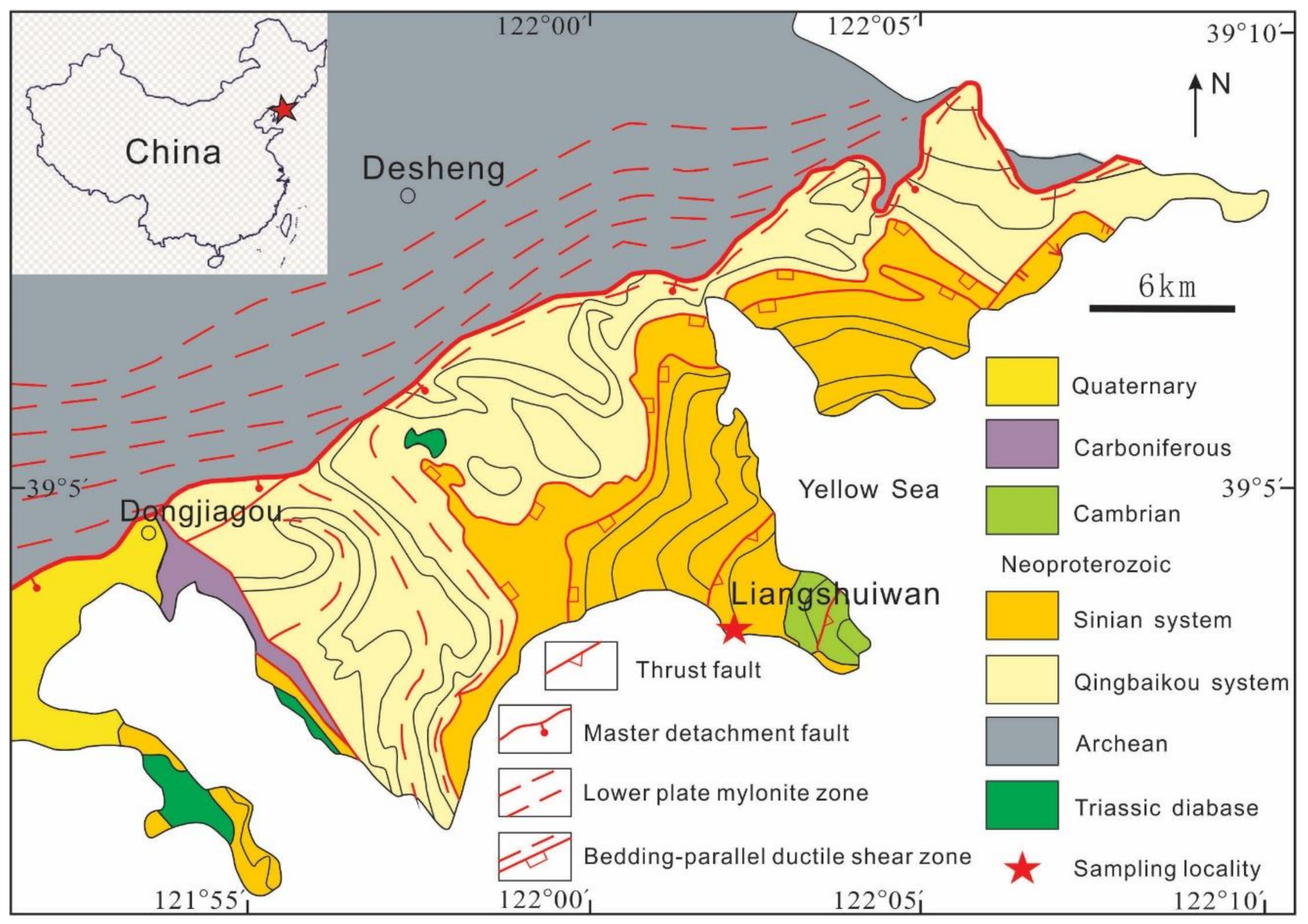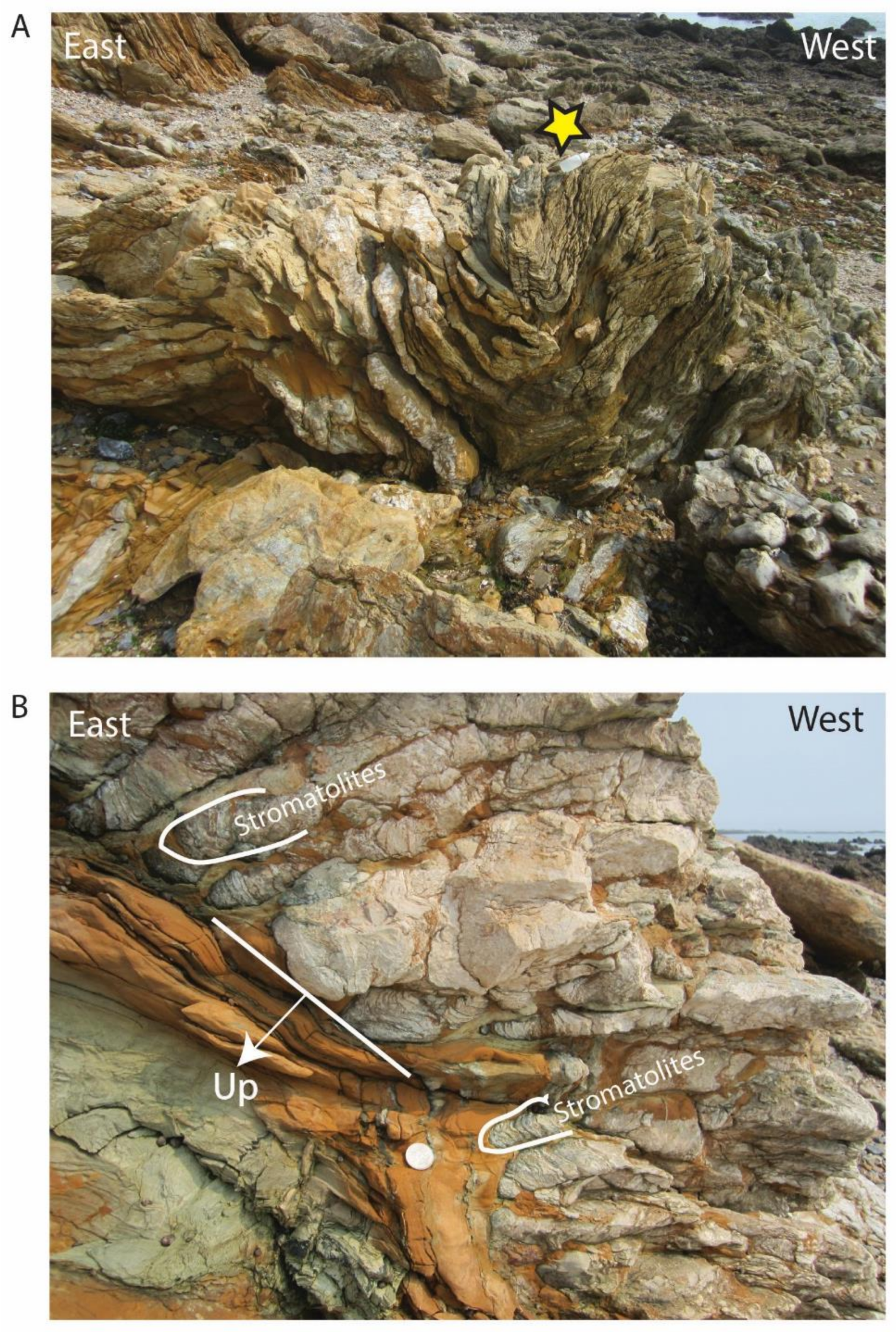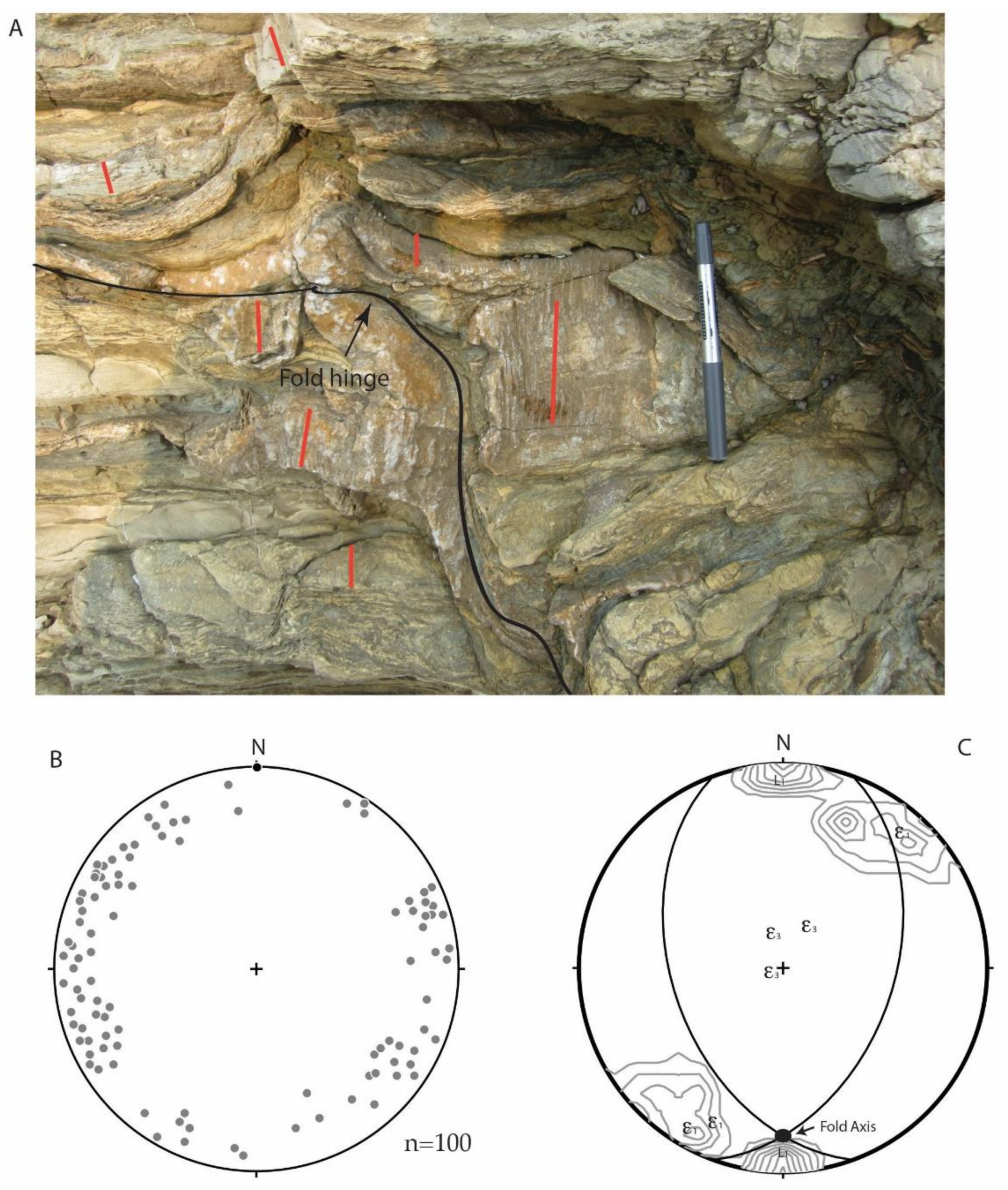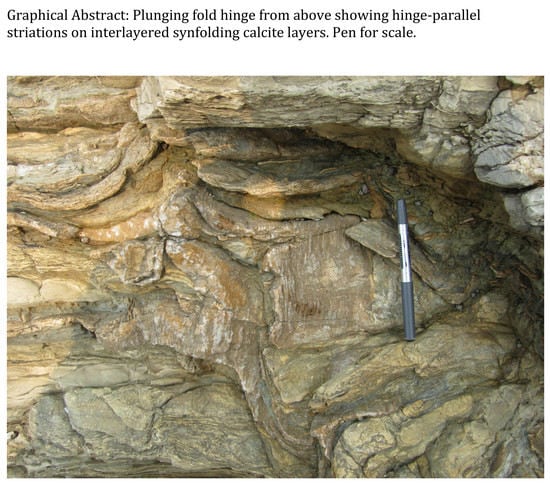Twinning Strains in Synfolding Calcite, Proterozoic Sinian System, China
Abstract
:1. Introduction
2. Methods
Calcite Twin Analysis
3. Results
3.1. Field Relations
3.2. Synfolding Twinning in Calcite
4. Discussion
5. Conclusions
Acknowledgments
Author Contributions
Conflicts of Interest
References
- Ramsay, J.G. Folding and Fracturing in Rocks; McGraw-Hill Publishers: New York, NY, USA, 1967; p. 568. [Google Scholar]
- Chapple, W.M.; Spang, J.H. Significance of layer parallel slip during folding of layered sedimentary rocks. Geol. Soc. Am. 1974, 85, 1523–1534. [Google Scholar] [CrossRef]
- Carter, N.L.; Friedman, M. Dynamic analysis of deformed quartz and calcite from the Dry Creek Ridge anticline, Montana. Am. J. Sci. 1965, 262, 747–785. [Google Scholar] [CrossRef]
- Burger, R.; Hamill, M.N. Petrofabric stress analysis of the Dry Creek Ridge anticline, Montana. Geol. Soc. Am. Bull. 1976, 87, 555–566. [Google Scholar] [CrossRef]
- Friedman, M.; Stearns, D.W. Relations bewteen Stresses inferred from Calcite Twin Lamelae and Macrofractures, Teton Anticline, Montana. Geol. Soc. Am. Bull. 1971, 82, 3151–3162. [Google Scholar] [CrossRef]
- Schmid, S.M.; Casey, M.; Starkey, J. The microfabric of calcite tectonites from the Helvetic Nappes (Swiss Alps). In Thrust and Nappe Tectonics; The Geological Society of London: London, UK, 1981; pp. 151–158. [Google Scholar]
- Hennings, P. Petrofabric implications for cover rock adjustment in basement-cored anticline: Dry Fork Ridge, Bighorn Mtns, Wyoming. Geol. Soc. Am. Abstr. Programs 1986, 18, 635. [Google Scholar]
- Hennings, P. Basement-Cover Relations of the Dry Fork Ridge Anticline Termination, Northeastern Bighorn Mountains, Wyoming and Montana. MSc Thesis, Texas A&M University, College Station, TX, USA, 1986. [Google Scholar]
- Fisher, D.M.; Anastasio, D.J. Kinematic analysis of a large scale leading edge fold, Lost River Range, Idaho. J. Struct. Geol. 1994, 16, 337–354. [Google Scholar] [CrossRef]
- Scott, W.H.; Hansen, E.; Twiss, R.J. Stress analysis of quartz deformation lamellae in a minor fold. Am. J. Sci. 1965, 263, 729–746. [Google Scholar] [CrossRef]
- Spang, J.H. Numerical dynamic analysis of calcite twin lamellae in the Greenport Center syncline. Am. J. Sci. 1974, 274, 1044–1058. [Google Scholar] [CrossRef]
- Groshong, R.H., Jr. Strain, fractures, and pressure solution in natural single-layer folds. Bull. Geol. Soc. Am. 1975, 86, 1363–1376. [Google Scholar] [CrossRef]
- Mitra, G. Microscopic deformation mechanisms and flow laws in quartites within South Mountain anticline. J. Geol. 1978, 86, 129–152. [Google Scholar] [CrossRef]
- Oertel, G. Strain in ductile rocks on the convex side of a folded competent bed. Tectonophysics 1980, 66, 15–34. [Google Scholar] [CrossRef]
- Spang, J.H.; Simony, P.S.; Mitchell, W.J. Strain and folding mechanism in a similar style fold from the northern Selkirks of the Canadian Cordillera. Tectonophysics 1980, 66, 253–267. [Google Scholar] [CrossRef]
- Spang, J.H.; Wolcott, T.L.; Serra, S. Strain in the Ramp Regions of Two Minor Thrusts, Southern Canadian Rocky Mountains, American Geophysical Union Monograph 24; American Geophysical Union: Washington, DC, USA, 1981; pp. 243–250. [Google Scholar]
- Spang, J.H.; Groshong, R.H., Jr. Deformation mechanisms and strain history of a minor fold from the Appalachian Valley and Ridge Province. Tectonophysics 1981, 72, 323–342. [Google Scholar] [CrossRef]
- Hudleston, P.J.; Holst, T.B. Strain analysis and fold shape in a limestone layer and implications for layer rheology. Tectonophysics 1984, 106, 321–347. [Google Scholar] [CrossRef]
- Onasch, C.M. Petrofabric test of viscous folding theory. Tectonophysics 1984, 106, 141–153. [Google Scholar] [CrossRef]
- Narahara, D.K. Wiltschko, Deformation in the hinge region of a chevon fold, Valley and Ridge Province, central Pennsylvania. J. Struct. Geol. 1986, 8, 157–168. [Google Scholar] [CrossRef]
- Hudleston, P.J.; Tabor, J.R. Strain and fabric development in a buckled clacite vein and rheological implications. Bull. Geol. Inst. Univ. Ups. 1988, 14, 79–94. [Google Scholar]
- Craddock, J.P.; Relle, M.K. Fold axis-parallel rotation within the Laramide Derby Dome fold, Wind River basin, WY. J. Struct. Geol. 2003, 25, 1959–1972. [Google Scholar] [CrossRef]
- Craddock, J.P.; McKiernan, A.; DeWit, M. Calcite twin analysis in synorogenic calcite, Cape Fold Belt: Implications for fold rotation and cleavage formation. J. Struct. Geol. 2007, 27, 1100–1113. [Google Scholar] [CrossRef]
- Craddock, J.P.; Klein, T.; Kowalczyk, G.; Zulauf, G. Calcite twinning strains in Alpine orogen flysch: Implications for thrust-nappe mechanics and the geodynamics of Crete. Lithosphere 2009, 1, 174–191. [Google Scholar] [CrossRef]
- Groshong, R.H., Jr. Strain calculated from twinning in calcite. Bull. Geol. Soc. Am. 1972, 83, 2025–2038. [Google Scholar] [CrossRef]
- Turner, F.J. Nature and dynamic interpretation of deformation lamellae in calcite of three marbles. Am. J. Sci. 1953, 251, 276–298. [Google Scholar] [CrossRef]
- Turner, F.J. Compression and tension axes deduced from (0112) Twinning in Calcite. J. Geophys. Res. 1962, 67, 1660. [Google Scholar]
- Kilsdonk, W.; Wiltschko, D.V. Deformation mechanisms in the southeastern ramp region of the Pine Mountain block, Tennessee. Geol. Soc. Am. Bull. 1988, 100, 644–653. [Google Scholar] [CrossRef]
- Engelder, T. The nature of deformation within the outer limits of the central Appalachian foreland fold-and-thrust belt in New York state. Tectonophysics 1979, 55, 289–310. [Google Scholar] [CrossRef]
- Wiltschko, D.V.; Medwedeff, D.A.; Millson, H.E. Distribution and mechanisms of strain within rocks on the northwest ramp of Pine Mountain block, southern Appalachian foreland: A field test of theory. Geol. Soc. Am. Bull. 1985, 96, 426–435. [Google Scholar] [CrossRef]
- Craddock, J.P.; van der Pluijm, B.A. Late Paleozoic deformation of the cratonic carbonate cover of eastern North America. Geology 1989, 17, 416–419. [Google Scholar] [CrossRef]
- Mosar, J. Internal deformation in the Prealpes Medianes, Switzerland. Eclogae Geol. Helv. 1989, 82, 765–793. [Google Scholar]
- Ferrill, D.A. Calcite twin widths and intensities as metamorphic indicators in natural low-temperature deformation of limestone. J. Struct. Geol. 1991, 13, 675–677. [Google Scholar] [CrossRef]
- Craddock, J.P.; Neilson, K.J.; Malone, D.H. Calcite twinning strain constraints on Heart Mountain detachment kinematics, Wyoming. J. Struct. Geol. 2000, 22, 983–991. [Google Scholar] [CrossRef]
- Craddock, J.P.; Moshoian, A.; Pearson, A.M. Kinematic analysis from twinned calcite strains in the marble mylonites of the central Grenville province, Canada. Geol. Soc. Am. Abstr. Programs 1991, 15, 236. [Google Scholar]
- Craddock, J.P.; Pearson, A. Non-coaxial horizontal shortening strains preserved in amygdule calcite, DSDP Hole 433C, Suiko Seamount. J. Struct. Geol. 1994, 16, 719–724. [Google Scholar] [CrossRef]
- Craddock, J.P.; Anziano, J.; Wirth, K.R.; Vervoort, J.D.; Singer, B.; Zhang, X. Structure, geochemistry and geochronology of a lamprophyre dike swarm, Archean Wawa terrane, Michigan, USA. Precambrian Res. 2007, 157, 50–70. [Google Scholar] [CrossRef]
- Wenk, H.-R.; Takeshita, T.; Bechler, E.; Erskine, B.G.; Matthies, S. Pure Shear and Simple Shear Calcite Textures. Comparison of Experimental, Theoretical and Natural Data. J. Struct. Geol. 1987, 9, 731–745. [Google Scholar] [CrossRef]
- Burkhard, M. Calcite twins, their geometry, appearance and significance as stress-strain markers and indicators of tectonic regime: A review. J. Struct. Geol. 1993, 15, 351–368. [Google Scholar] [CrossRef]
- Lacombe, O.; Laurent, P. Determination of deviatoric stress tensors based on inversion of calcite twin data from experimentally deformed monophase samples: Preliminary results. Tectonophysics 1996, 255, 189–202. [Google Scholar] [CrossRef]
- Ferrill, D.A. Critical re-evaluation of differential stress estimates from calcite twins in coarse-grained limestone. Tectonophysics 1998, 285, 77–86. [Google Scholar] [CrossRef]
- Groshong, R.H., Jr.; Teufel, L.W.; Gasteiger, C.M. Precision and accuracy of the calcite strain-gage technique. Bull. Geol. Soc. Am. 1984, 95, 357–363. [Google Scholar] [CrossRef]
- Groshong, R.H., Jr. Experimental test of least-squares strain calculations using twinned calcite. Bull. Geol. Soc. Am. 1974, 85, 1855–1864. [Google Scholar] [CrossRef]
- Rowe, K.J.; Rutter, E.H. Paleostress estimation using calcite twinning: Experimental calibration and application to nature. J. Struct. Geol. 1990, 12, 1–17. [Google Scholar] [CrossRef]
- Teufel, L.W. Strain analysis of experimental superposed deformation using calcite twin lamellae. Tectonophysics 1980, 65, 291–309. [Google Scholar] [CrossRef]
- Evans, M.A.; Groshong, R.H. A Computer Program for the Calcite Strain-Gage Technique. J. Struct. Geol. 1994, 16, 277–281. [Google Scholar] [CrossRef]
- Ferrill, D.A.; Morris, A.P.; Evans, M.A.; Burkhard, M.; Groshong, R.H.; Onasch, C.M. Calcite Twin Morphology: A Low-Temperature Deformation Geothermometer. J. Struct. Geol. 2004, 26, 1521–1529. [Google Scholar] [CrossRef]
- Gray, M.B.; Stamatakos, J.A.; Ferrill, D.A.; Evans, M.A. Fault-Zone Deformation in Welded Tuffs at Yucca Mountain, Nevada, USA. J. Struct. Geol. 2005, 27, 1873–1891. [Google Scholar] [CrossRef]
- Liu, J.; Davis, G.A.; Lin, Z.; Wu, F. The Liaonan Metamorphic Core Complex, Southeastern Liaoning Province, North China: A Likely Contributor to Cretaceous Rotation of Eastern Liaoning, Korea and Contiguous Areas. Tectonophysics 2005, 407, 65–80. [Google Scholar] [CrossRef]
- Yang, T.N.; Peng, Y.; Leech, M.L.; Lin, H.Y. Fold patterns indicating Triassic constrictional deformation on the Liaodong peninsula, eastern China, and tectonic implications. J. Asian Earth Sci. 2011, 40, 72–83. [Google Scholar] [CrossRef]
- Wang, Z.X.; Tang, Z.M.; Yang, Z.Z.; Yang, X.B. Redetermination of the Meso-Cenozoic structural framework of Dalian area. Reg. Geol. China 2000, 19, 120–126. [Google Scholar]
- Avdeivitch, N.N. Geodynamic Evolution of the Cretaceous Liaonan Metamorphic Core Complex, Northeast China: New Insights from Calcite Twin Paleostress Analysis. Honors Thesis, Macalester College, St. Paul, MN, USA, 2013; p. 63. [Google Scholar]
- Nuriel, P.; Weinberger, R.; Kylander-Clark, A.R.C.; Hacker, B.C.; Craddock, J.P. The onset of the Dead Sea transform based on calcite age-strain analyses. Geology 2017, 45, 587–590. [Google Scholar] [CrossRef]
- Conel, J.E. Studies of the Development of Fabrics of Some Naturally Deformed Limestones. Ph.D. Thesis, California Institute of Technology, Pasadena, CA, USA, 1962; p. 257. [Google Scholar]
- Fletcher, R.C. Analysis of flow in layer viscous fluids at small, but finite amplitude, with application to mullion structures. Tectonophysics 1982, 81, 51–66. [Google Scholar] [CrossRef]
- van der Pluijm, B.A.; Craddock, J.P.; Graham, B.R.; Harris, J.H. Paleostress in Cratonic North America; Implications for Deformation of Continental Interiors. Science 1997, 277, 794–796. [Google Scholar] [CrossRef]
- Craddock, J.P.; van der Pluijm, B.A. Regional stress-strain fields of Sevier-Laramide tectonism from calcite twinning data, west-central North America. Tectonophysics 1999, 305, 275–286. [Google Scholar] [CrossRef]
- Craddock, J.P.; Jackson, M.; van der Pluijm, B.A.; Versical, R. Regional shortening fabrics in eastern North America: Far-field stress transmission from the Appalachian–Ouachita orogenic belt. Tectonics 1993, 12, 257–264. [Google Scholar] [CrossRef]
- Craddock, J.P.; Malone, D.H.; Porter, R.; Luczaj, J.; Konstantinou, A.; Day, J.E.; Johnston, S.T. Paleozoic reactivation structures in the Appalachian-Ouachita-Marathon foreland: Far-field deformation across Pangea. Earth-Sci. Rev. 2017, 169, 1–34. [Google Scholar] [CrossRef]
- Craddock, J.P. Transpression during tectonic evolution of the Idaho-Wyoming fold-and-thrust belt. Geol. Soc. Am. Mem. 1992, 179, 125–139. [Google Scholar]
- Craddock, J.P.; Craddock, S.D.; Konstantinou, A.; Kylander-Clark, A.; Malone, D.H. Calcite Twinning Strain Variations across the Proterozoic Grenville Orogen and Keweenaw-Kapuskasing Inverted Foreland, USA and Canada. Geosci. Front. 2017, 8, 1–29. [Google Scholar] [CrossRef]
- Klein, T.; Craddock, J.P.; Zulauf, G. Constraints on the geodynamical evolution of Crete: Insights from illite crystallinity, Raman spectroscopy and calcite twinning above and below the “Cretan detachment”. Int. J. Earth Sci. 2013, 102, 139–182. [Google Scholar] [CrossRef]



| Sample | Rock Unit | Orientation | Grains (n=) | ε1 | ε2 | ε3 | e1 (%) | NEV (%) | Δσ (MPa) | Fabric Interp. |
|---|---|---|---|---|---|---|---|---|---|---|
| (Bedding) | (Vein) | |||||||||
| Limb | Sinian System | N 25° E, 45° SE | 34 | 46°, 4° | 145°, 12° | 278°, 82° | −1.8 | 11 | −38.6 | VPS, LPS |
| Hinge | Sinian System | N 90° E, 20° S | 33 | 212°, 14° | 303°, 28° | 37°, 61° | −5.7 | 0 | −38.3 | VPS, LPS |
| Limb | Sinian System | N 25° W, 45°SW | 33 | 214°, 7° | 138°, 11° | 3°, 72° | −1.2 | 6 | −38.2 | VPS, LPS |
| n = 100 | Avg = −38.3 |
© 2018 by the authors. Licensee MDPI, Basel, Switzerland. This article is an open access article distributed under the terms and conditions of the Creative Commons Attribution (CC BY) license (http://creativecommons.org/licenses/by/4.0/).
Share and Cite
Craddock, J.P.; Liu, J.; Zheng, Y. Twinning Strains in Synfolding Calcite, Proterozoic Sinian System, China. Geosciences 2018, 8, 131. https://doi.org/10.3390/geosciences8040131
Craddock JP, Liu J, Zheng Y. Twinning Strains in Synfolding Calcite, Proterozoic Sinian System, China. Geosciences. 2018; 8(4):131. https://doi.org/10.3390/geosciences8040131
Chicago/Turabian StyleCraddock, John P., Junlai Liu, and Yuanyuan Zheng. 2018. "Twinning Strains in Synfolding Calcite, Proterozoic Sinian System, China" Geosciences 8, no. 4: 131. https://doi.org/10.3390/geosciences8040131
APA StyleCraddock, J. P., Liu, J., & Zheng, Y. (2018). Twinning Strains in Synfolding Calcite, Proterozoic Sinian System, China. Geosciences, 8(4), 131. https://doi.org/10.3390/geosciences8040131





